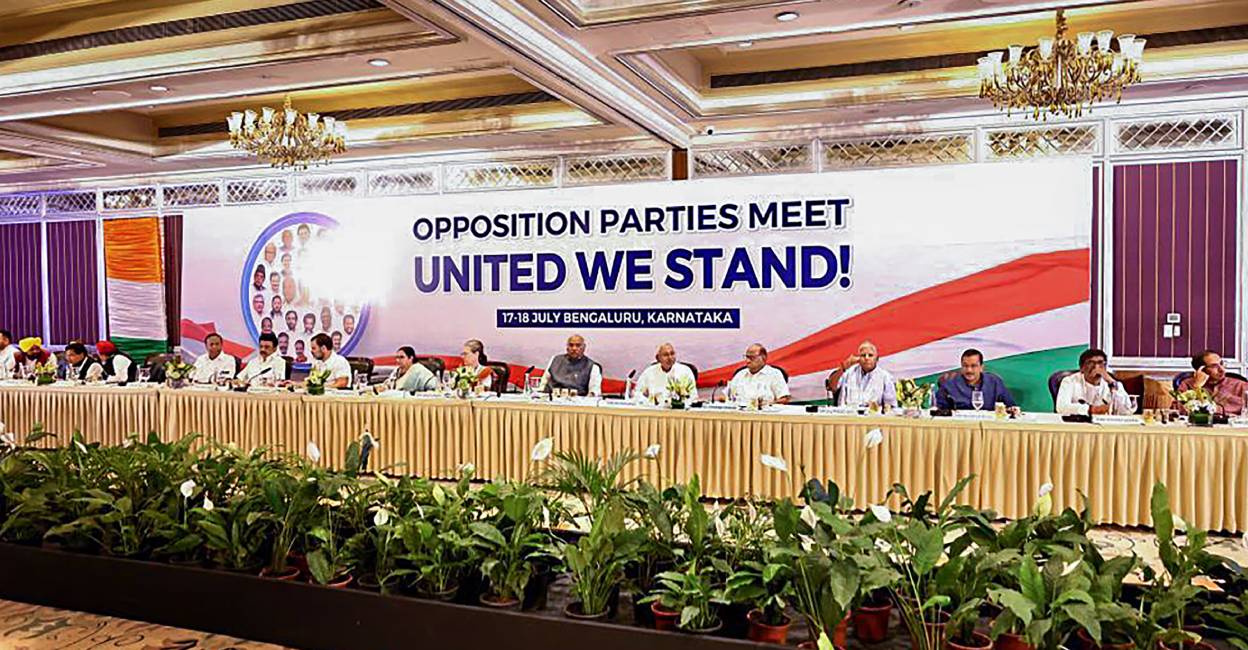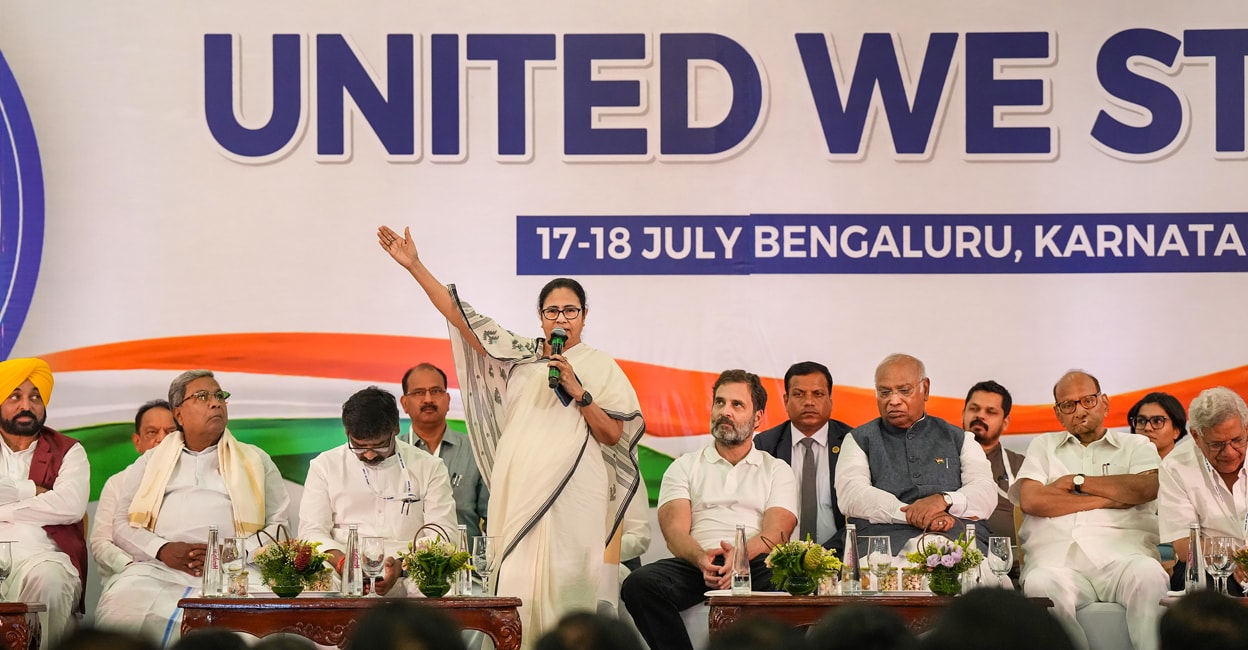Onmanorama Explains | NDA vs INDIA: What the numbers say

Mail This Article
Indian politics witnessed a crucial development on June 18 as 26 parties came together to form an alliance to take on the Narendra Modi-led Bharatiya Janata Party (BJP) in the 2024 general elections.
The parties, including the Congress, Trinamool Congress (TMC) and Dravida Munnetra Kazhagam (DMK), named their alliance Indian National Developmental Inclusive Alliance or INDIA in what is seen politically as a smart move.
'Jeetega Bharat' or 'India will win', the alliance's tagline, sets the tone for its 2024 Lok Sabha campaign. The name as well as the tagline are seemingly part of attempts to take on the BJP’s aggressive nationalist pitch nevertheless.
Meanwhile, BJP leaders including prime minister Narendra Modi slammed the alliance members as opportunists and corrupt who defamed India globally but were now trying to save their existence and their families.
The alliance took shape in a two-day meeting held in a Bengaluru hotel on June 17 and 18. It was the follow-up of the first meeting in this context held in Patna on June 24. However, there were just 16 parties in attendance in Patna.
That said, with the formation of INDIA, the long pending question of opposition unity in the country to take on the BJP juggernaut has been addressed, at least for now.
The 26 opposition parties which are part of the opposition alliance are the Congress, TMC, DMK, AAP, JD(U), RJD, JMM, NCP (Sharad Pawar), Shiv Sena (UBT), SP, NC, PDP, CPI(M), CPI, RLD, MDMK, Kongunadu Makkal Desia Katchi (KMDK), VCK, RSP, CPI-ML (Liberation), Forward Bloc, IUML, Kerala Congress, Kerala Congress (Mani), Apna Dal (Kamerawadi) and the Manithaneya Makkal Katchi (MMK).
The next meeting of INDIA is likely to be held after August 15 in Mumbai. Then the alliance is likely to finalise an 11-member coordination committee. The Mumbai meet will be the third after the Patna and Bengaluru gatherings.
The alliance leaders are also planning to set up four to five committees including for campaign management, communication and overseeing rallies.
The Mumbai meeting will be crucial since the coalition is likely to discuss among its allies important topics such as seat-sharing, poll preparations and campaign management. The Congress, the biggest ally of the coalition and the main opponent to several of the partners in their strongholds, has made it clear that it is not interested in the prime minister post in case of the alliance coming to power.
The alliance consists of three national parties, 17 state parties and six unrecognised parties. Nineteen of the 26 outfits have less than three seats in the Lok Sabha.

NDA vs INDIA: What numbers say
With the formation of INDIA alliance, the BJP has initiated efforts to rejuvenate the National Democratic Alliance (NDA) it heads. The coalition has been inactive for years with its main ally BJP emerging all powerful with its majority in the 2019 elections. The party has 301 seats in the 543-member Lok Sabha while its partners add another 28 seats to the tally.
In 2019, the electoral fight was mainly between the NDA and the Congress-led United Progressive Alliance (UPA). The UPA could then manage to win only 92 seats, with the Congress winning 52. The UPA’s numbers went up to 114 later with the then Shiv Sena - now the Uddhav Thackeray faction - and Janata Dal United leaving the saffron front to join the opposition camp.
UPA has in effect seized to exist with the formation of INDIA which has 157 members in the Lok Sabha now. It is still less than half of NDA's 329 in the lower house of the Parliament.
Coming to vote share gathered in 2019, NDA had polled 45% with BJP alone bagging 37.76% of it.
The INDIA combine meanwhile has 38.72% of vote share as per the 2019 results. (Note: There could be minor differences in the figures provided the splits and switching of allegiances by parties since the 2019 results).
From a wider perspective, the NDA looks stronger in the Hindi heartland and larger states like Uttar Pradesh (UP), Madhya Pradesh and Rajasthan. UP alone sends 80 members to the Lok Sabha. In 2019, BJP bagged 63 of them.
The INDIA alliance meanwhile has its strongholds in Congress-ruled Karnataka, Mamata Banerjee’s West Bengal, M K Stalin’s Tamil Nadu and AAP’s Delhi and Punjab. AAP joined the combine after Congress declared its opposition to the Centre’s ordinance on controlling services in Delhi. However, all the assessments of the so-called fortresses may go wrong provided people tend to vote differently in state and general elections.

Weak points
The coming together of the 26 parties has not been an easy task provided the bitter relationships some of the partners share in states. Tension is likely to go up over seat-sharing among partners in states like Kerala, Punjab, and West Bengal. An alliance will not be possible between the Congress and the Left in Kerala at the moment. The situation will be difficult for the Left and Trinamool Congress in West Bengal, and the AAP and the Congress in Punjab and Delhi.
Samajwadi Party and the Congress in Uttar Pradesh and PDP and National Conference in Jammu and Kashmir are not without their own differences.
Fence-sitters
While 65 parties have chose o be a part of the ruling NDA or opposition INDIA, at least 11 crucial players are yet to join either of the fronts. These parties have a total of 91 members in Parliament.
Three of the fence-sitters rule fairly large states of Andhra Pradesh (YSRCP), Telangana (BRS) and Odisha (BJD) that together send 63 members to Lok Sabha. Congress and its current allies have been decimated in these states while BJP has also been unable to make any significant inroads.
The parties that are part of neither grouping are: YSR Congress Party (YSRCP) Biju Janata Dal (BJD), Bharat Rashtra Samithi (BRS), Bahujan Samaj Party, All India Majlis-E-Ittehadul Muslimeen (AIMIM), Telugu Desam Party (TDP), Shiromani Akali Dal (SAD), All India United Democratic Front (AIUDF), Janata Dal (Secular), Rashtriya Loktantrik Party (RLP) and SAD (Mann).
(With inputs from PTI)


